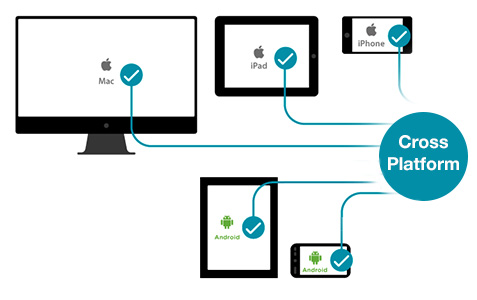Do you know What is Cross Platform Software, and how does it work? Cross Platform Software is a sort of Software that runs on several operating systems and computers, referred to as platforms. An operating system, such as Windows, Mac OS, Android, or iOS, is a platform. If a software program supports several formats, the user can use it in various devices and computers.
Advantages of Cross Platform Software
A Cross Platform Software or application has the benefit of allowing you to use the same program whether you’re on a Windows PC, a laptop, or a smartphone. Word, Excel, and PowerPoint are part of the Microsoft Office suite, available for Windows, Mac OS, iOS (iPhone/iPad), and Android. However, there are variations in how the platforms function; you’ll have a consistent experience across all of your devices when using the app.
Since you’ll be able to use a Cross Platform Software product you’re familiar with regardless of the operating system or computer you use, having a similar experience across all platforms ensures there’s a much smaller learning curve if one exists at all.

Furthermore, your files can be transferred between devices even more quickly, allowing you to use the Software with whatever computer you have on hand at the time.
File Synchronization with Cloud Storage
Cloud storage is not required for Cross Platform Software, but it is often built into the Software to make it easier to keep your documents and files in sync with all of your devices. Apple and Google also provide cloud storage for their cross-platform apps, and Microsoft’s Office 365 can automatically save your office files to a cloud drive.
If you have an Android phone, an iPad, and a Windows PC, you have three different platforms with three other operating systems. Evernote, a standard note-taking software, is compatible with both of these platforms, as well as Mac OS.
Evernote allows you to make a note on your phone and have it repeated on every other computer that has the Evernote software installed.
Larger organizations prefer Cross Platform Software
Large organizations, such as companies and government agencies, may use cross-platform software applications to keep their Software running regardless of the hardware platform or operating system. Since the investment in software applications is much greater than the investment in hardware for a large enterprise like a college or a Fortune 500 corporation, Cross Platform Software helps an organization to make hardware decisions independent of the software application.
Examples of Cross-platforms
Unity3D
First, let’s go over Unity3D. People who want to make mobile games should use the game engine, in my opinion. You can create games in 17 different languages on 17 other platforms, including Linux. The most suitable game engine for designing games is iOS, Android, and Windows Phone.
Your program can be written in C#, Javascript, or C++.
Link to: https://unity3d.com
Xamarin
Xamarin was recently acquired by Microsoft and is an excellent choice for C# developers. Xamarin is the language of choice for C # developers because it is a C # language with comprehensive documentation and Microsoft support. The Xamarian library also allows you to do whatever you can in Objective-C, Swift, and Javada.
Link to: https://xamarin.com
React Native
React Native is an open-source JavaScript library created by Facebook’s latest React generation, released to Github in 2013. Writing Software for a single operating system is referred to as native application development.
React Native allows developers to reuse code on the web and mobile devices. Developers would not have to build the same Software for iOS and Android from the ground up. In each operating system, they would be able to reuse the code. The beauty of React Native is that it’s difficult to tell the difference between a finished program written in Objective-C or Java and one written in React Native. The code creation environments for Android and iOS are vastly different.
As a result, removing the application from two separate platforms takes time. With React Native, however, only one developer can write for multiple mobile operating systems.
Native applications have the following benefits:
- Excellent results: Native apps can handle high-end graphics and animations while still delivering quick response times.
- Offering a straightforward user experience: The same UI elements and gestures are used in native apps as in other platform-specific apps.
Native applications have the following Drawbacks:
Each platform would need its team. Each native app is designed from the ground up, with no possibility of sharing the codebase across platforms. It takes twice as long to test and repair bugs. Designers often have to do their work twice because the development specifications for and forum are different.
The majority of startups are unable to cover the costs. The project’s cost is influenced by the number of specialists needed and the amount of time spent developing the app. Don’t forget to factor in the price of funding two different applications.
App production for Multiple Platforms
Cross Platform Software or applications combine the best of both worlds: they’re actual apps that you run on your mobile, and consumers can’t tell they’re not using a native app in most situations. Simultaneously, there’s no need to recruit two different development teams because iOS and Android apps use the same toolset: one of several JavaScript frameworks or Google’s latest Flutter.
Cross-platform Applications have the following benefits:
- Outstanding results: A cross-platform mobile app outperforms a web-based app inefficiency and can satisfy almost any requirement.
- Low-cost and fast growth: A cross-platform app has a substantially shorter development time and lower cost than a native app.
- The appearance of a native environment: Most of the time, a user won’t understand a cross-platform app because it uses the same hardware and native controllers as native apps.
Cross-platform Applications have the following drawbacks:
- Skills are minimal: Only native code can access those platform-specific features. You won’t be able to use augmented reality in a cross-platform app, for example.
Conclusion
The Cross Platform Software architecture was once thought to be a low-cost, low-quality compromise approach that only startups with no initial investment can opt for. These days, however, are over. React Native is now used by unicorns, including Uber and Pinterest, to speed up growth and offer high-quality updates. Banks favor ionic for security-critical apps because it meets their needs. Startups prefer ionic because of its quick development time, ability to iterate quickly, and unquestionable reliability.

